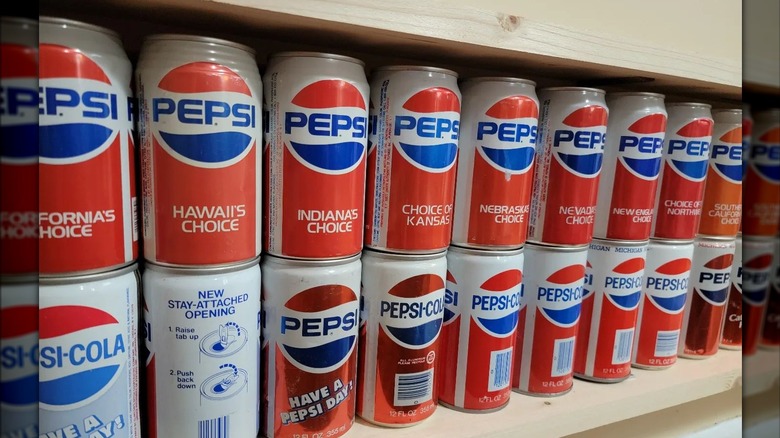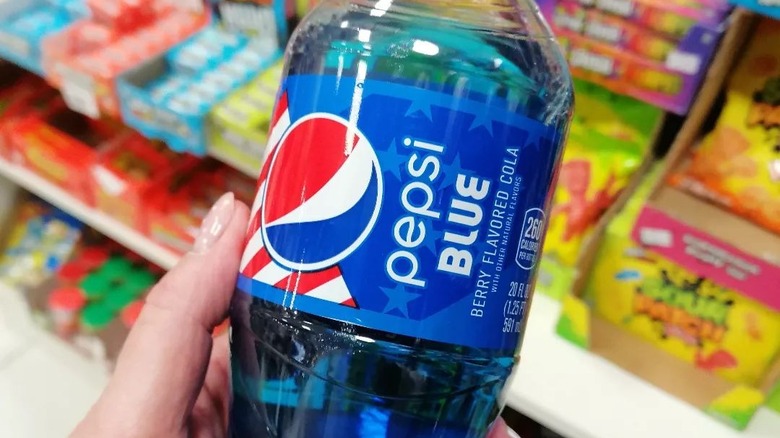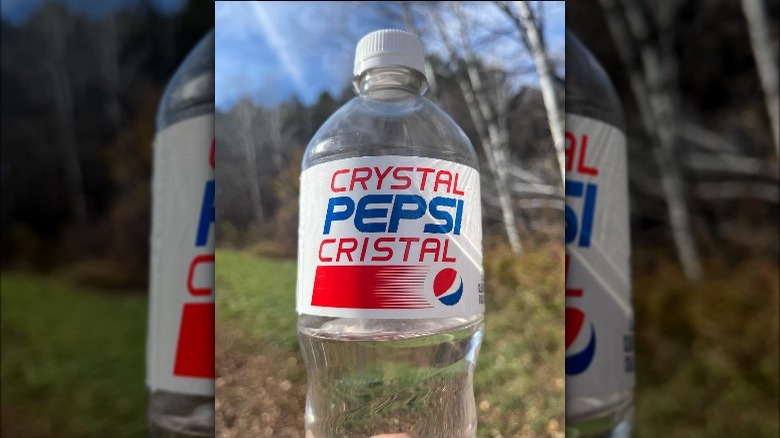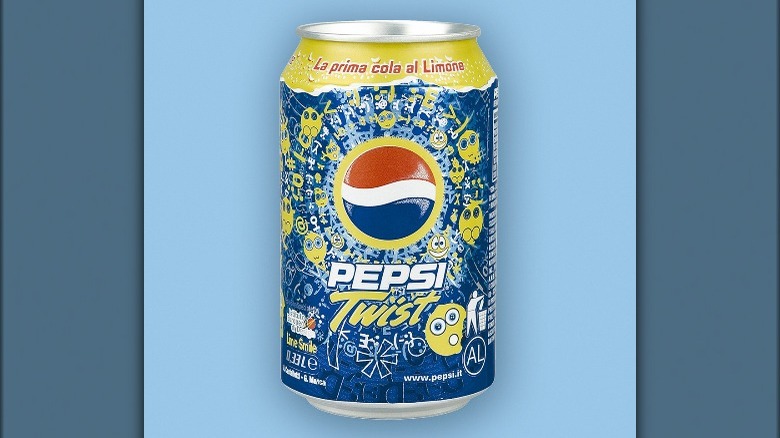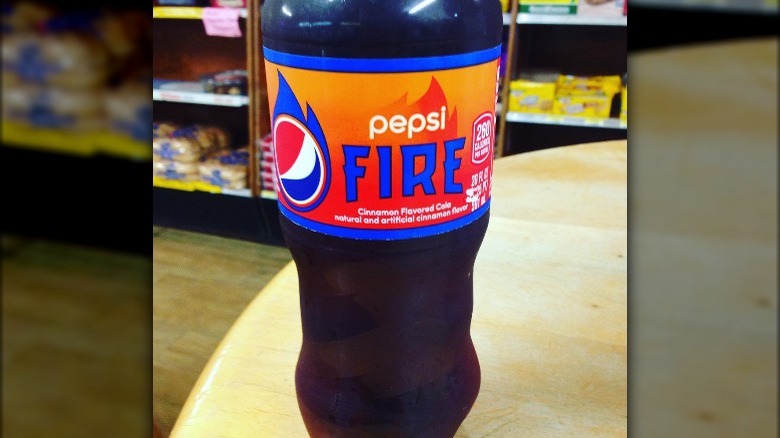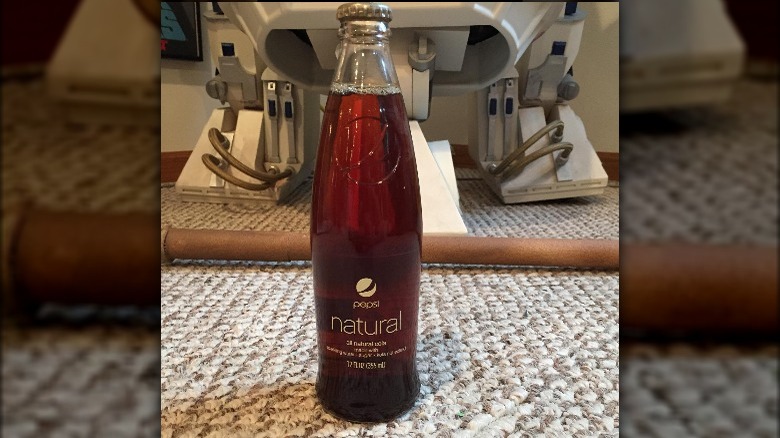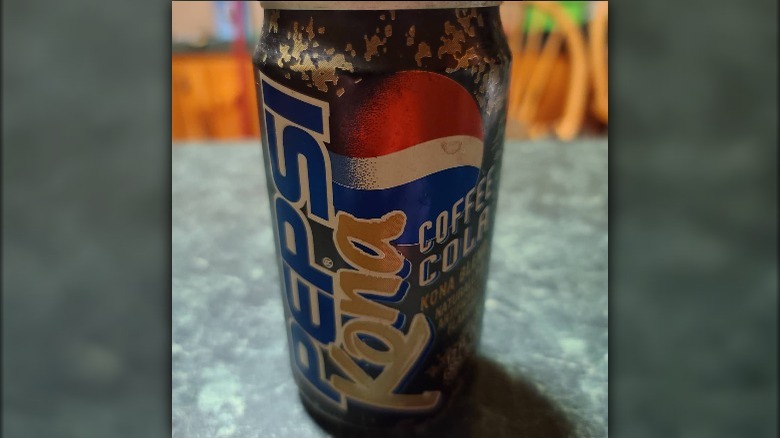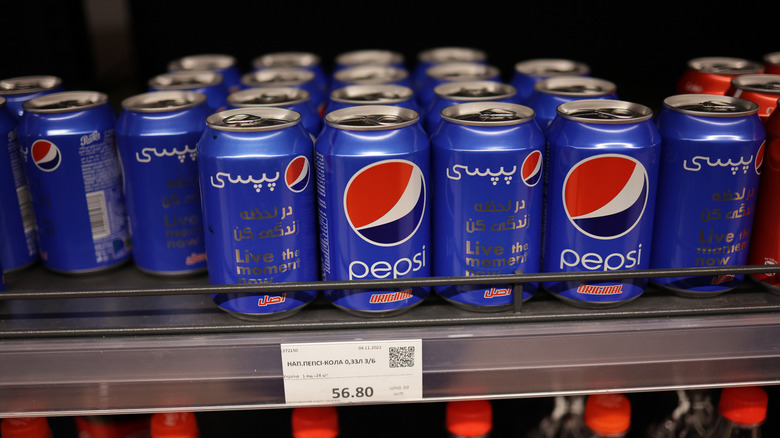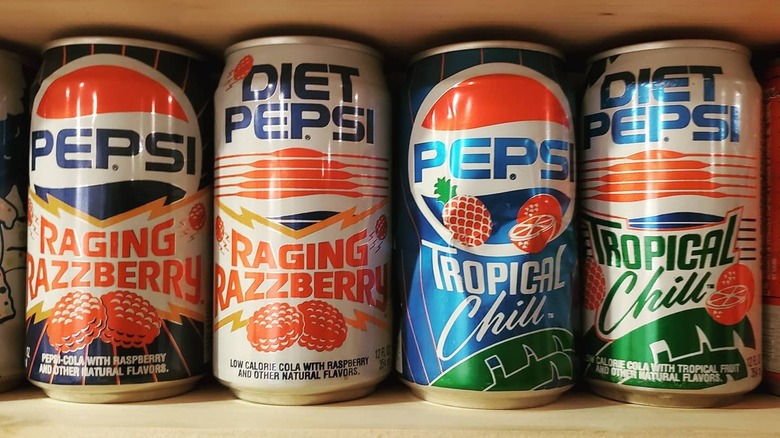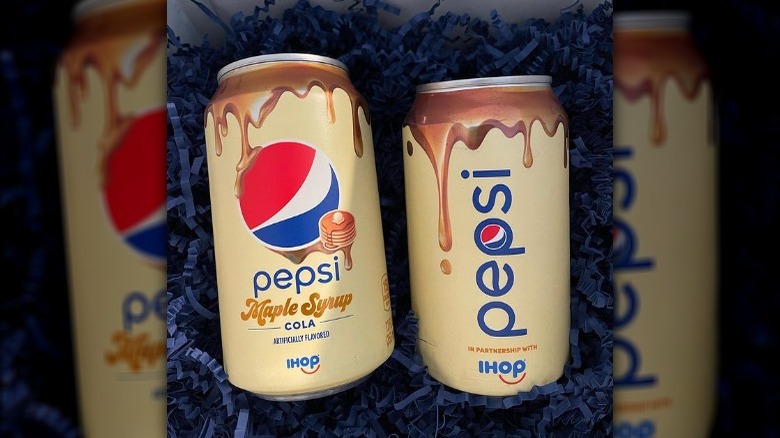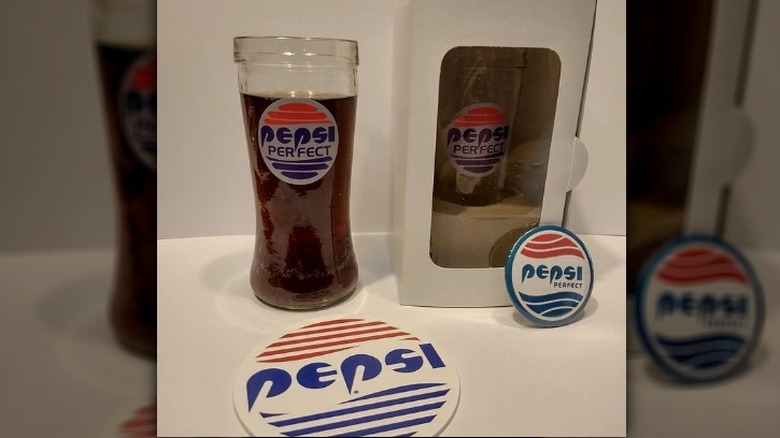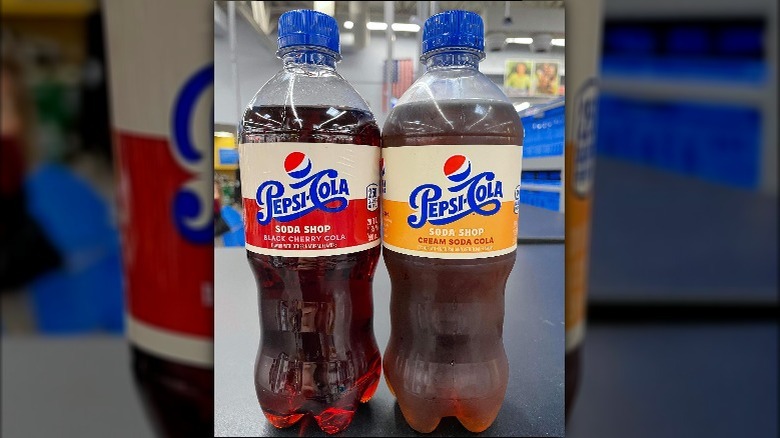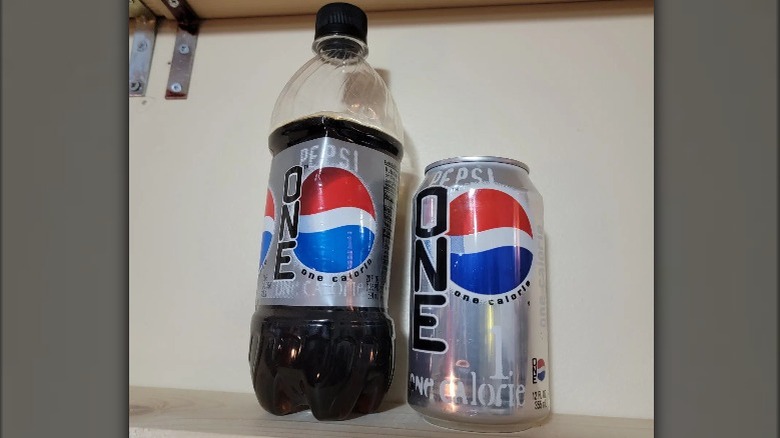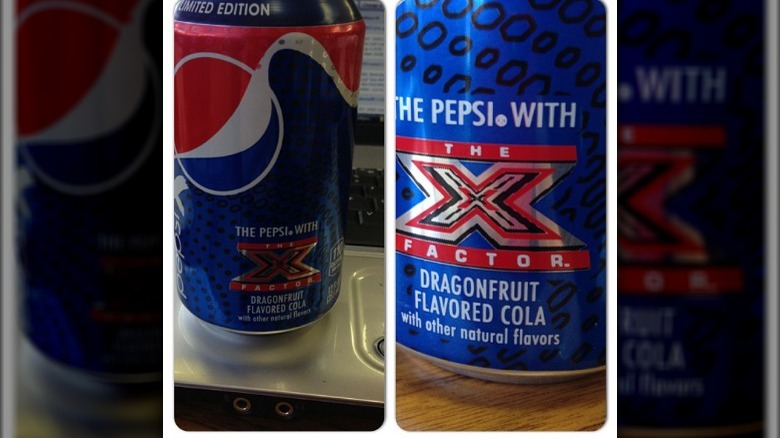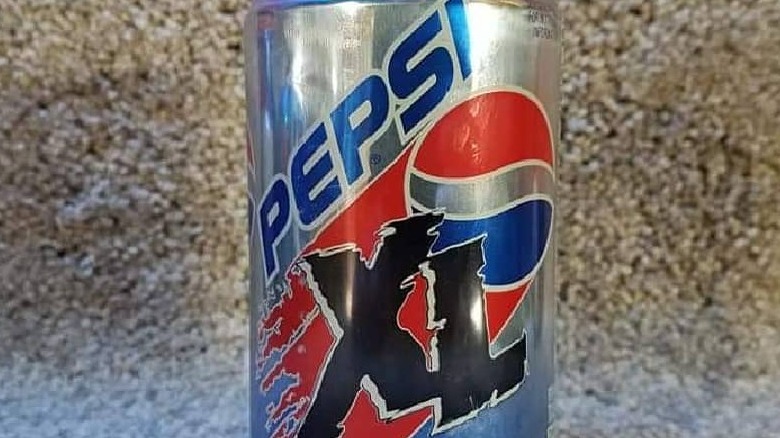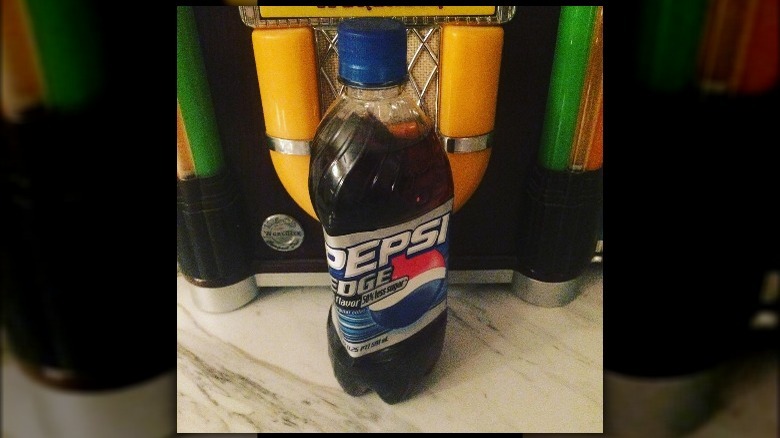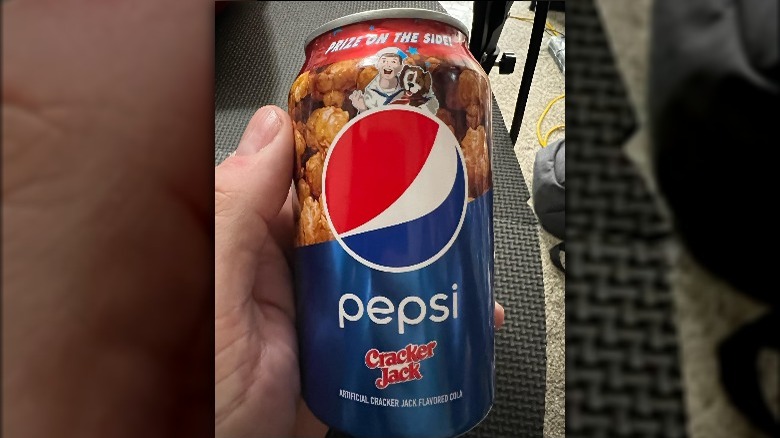Discontinued Pepsi Flavors You'll Never Drink Again
We may receive a commission on purchases made from links.
Soda brands, spurred by a never-ending battle to win over consumers, are constantly releasing new flavors. Some unique flavors stand the test of time and become instant favorites, like Mountain Dew Baja Blast and Pepsi Wild Cherry. Others disappear from shelves and coolers as quickly as they appeared, never to grace our taste buds again.
Pepsi, throughout its long and rocky history, has had its share of failed flavors. But like its big competitor, Coke, Pepsi continues to test the waters. Some new flavors are designed to capture taste buds, while others are created with the intention of going viral on social media (like Twitter) with a new contest or promotion. This isn't a new trend, though: Pepsi has been trying out new flavors for many decades (via Time Toast).
Have you loved and lost a Pepsi flavor that the brand discontinued? There are so many controversial, unsuccessful, or otherwise discontinued Pepsi flavors that you'll likely never get to drink again.
Pepsi Blue
Today, funky-colored sodas that look more like window cleaner than a drink are common. But this wasn't the case in 2002. So, when Pepsi decided to roll out a new berry-flavored pop, it likely came as a surprise when the focus groups suggested making the soda blue (via The Wall Street Journal). The brand had planned to release the new soda with a dark, traditional color. But teenage focus groups requested the bright blue hue.
Pepsi was likely also inspired by the success of its release of Mountain Dew Code Red the previous year (via USA Today). Pepsi Blue's release was announced just one day before Coca-Cola debuted Vanilla Coke, which was the brand's attempt to win over soda drinkers who preferred something sweeter. Pepsi Blue's sweet, "berry cola fusion" soda was designed to target the taste buds of 12-17-year-olds (via Mental Floss). But it failed to win over older consumers.
Pepsi Blue sold 17 million cases in its first year and just 5 million in the following (via Snack History). But dropping sales may not have been the only reason that the flavor was discontinued shortly after the end of 2003. Around the same time, concerns about the controversial blue dye used to give Pepsi Blue its cobalt blue shade also came to light. The dye, called "Brilliant Blue" or Blue No. 1, is banned in several countries, though not in the U.S. (via Scientific American).
Crystal Pepsi
A decade before cobalt-colored Pepsi Blue hit the shelves, the opposite (a soda with no color) debuted (via People). When Crystal Pepsi was released in 1992, it joined hoards of other products being released in "clear" renditions. David Novak, the CEO of Yum Brands at the time, created the drink and was inspired by a movement among the public that saw clear beverages as "healthier (via Business Insider). But despite the very different appearance, the drink tasted similar to regular Pepsi, minus the caffeine. But it may not have tasted similar enough.
Crystal Pepsi failed to gain traction, and it was on shelves for just one year before it was discontinued. While it wasn't a success in the early '90s, growing nostalgia for that time led the soda to make a comeback in early 2022 (via CNN Business). A Twitter photo contest had participants submitting photos of themselves from the '90s. Pepsi awarded 300 lucky winners their own 6-pack of 20-ounce bottles of Crystal Pepsi.
Pepsi Twist
Plenty of sodas from the early 2000s were discontinued just months after their release. But Pepsi Twist struck a chord with consumers, and it managed to stick around for over 5 years (via Liquid Search). When the lemon-flavored take on classic Pepsi was released, first to test markets in July 2000 and then nationwide in June 2001, it actually wasn't the brand's first citrusy soda.
In the 1970s and '80s, Pepsi Light had a slight lemon taste (via Nostalgia Central). But this wasn't totally planned; instead, the lemon flavor was used to offset the aftertaste of the artificial sweetener that was used to cut calories in the drink.
Pepsi Twist was heavily marketed, and advertisements that appeared during the 2003 Super Bowl featured the Osbourne family, including Ozzy, Jack, and Kelly, and Donny and Marie Osmond (via YouTube). On regular TV, funny commercials featuring penguins trying to cool off on a hot day kept consumers captivated (via The Guardian).
The refreshing taste helped this soda hold on until the Summer of 2006. The drink enjoyed a brief re-release in 2008 as the NFL Kickoff Limited Edition Flavor. But Pepsi has no plans of bringing back this once-popular flavor in the future (via Twitter).
Pepsi Fire
With a logo like "Get It While It's Hot," it seems that Pepsi might have known that demand for this controversial flavor would cool down pretty quickly among consumers (via PR Newswire). Pepsi Fire debuted in May 2017 for an eight-week release. The drink featured classic Pepsi with a dash of cinnamon flavor. Just before its release in cans and bottles, the flavor was also released as a limited-edition Slurpee flavor, available at 7-11 locations in Michigan (via The Street).
According to some, Pepsi Fire was a distinct, non-alcohol soda version of a cinnamon-flavored vodka (via The Impulsive Buy). But this was far from Pepsi's biggest scandal at the time. While it was no doubt in production for months (if not longer) before its release, Pepsi Fire debuted just weeks after the brand was engulfed in backlash from its infamous commercial featuring Kendall Jenner joining protestors and handing over a can of Pepsi to police officers (via The New York Times). Planned or not, marketing for Pepsi Fire was widespread, even though the flavor was only briefly available for a limited time that summer.
Pepsi Natural
In yet another bid to win over health enthusiasts, Pepsi released a brand new flavor in early 2009 (via Bev Industry). Pepsi Natural was made from sparkling water, sweetened with natural sugar, and flavored with caramel and kola nut extract. The variation was meant to be a healthier take on regular Pepsi, dropping the controversial corn syrup.
Even where Pepsi chose to sell the flavor was a part of a carefully curated campaign to win over its audience. The tall, sleep glass bottles Pepsi Natural came in were only available in the aisle of natural food stores in a few select markets, including Seattle, San Francisco, Los Angeles, New York, and Chicago (via Reuters).
Pepsi Natural was released in the Spring of 2009 along with two other Pepsi products: Mountain Dew Throwback and Pepsi Throwback. While these weren't designed to win over health enthusiasts, they were created to inspire nostalgia in customers, both with their can and bottle designs and with the use of natural sugar instead of artificial sweeteners. Pepsi Natural failed to catch on in its small market, and it was discontinued shortly after its release (via Caffeine Informer).
Pepsi Kona
Pepsi Kona debuted in 1996 (via Reference). This java-flavored Pepsi was designed to act as an alternative to coffee, and it featured the regular Pepsi blend mixed with natural and artificial flavors of Kona-blend coffee (via Wild World of Pepsi). A diet version of Pepsi Kona was also available at the time. Both featured an eye-catching black can that was decorated with a light brown design and featured Pepsi's bold '90s logo.
Do you think that Pepsi was trying to compete with the rapidly-growing Starbucks chain? Think again! Two years before Pepsi Kona was released, Pepsi and Starbucks actually started a joint venture. The goal was to bring a "ready to drink" coffee to the market (via Encyclopedia). This joint venture was named the "The North American Coffee Partnership."
Starbucks provided the knowledge of coffee, while PepsiCo actually created and sold the canned and bottled coffee creations. This partnership has lasted more than 20 years and has led to the development of many of Starbucks' popular "ready to drink" creations, like its Double Shot Coffee & Protein Drinks and the popular glass bottle Frappuccino beverages.
Pepsi Kona wasn't created as a partnership with Starbucks but as an attempt by Pepsi to utilize its new coffee knowledge. But despite heavy advertising, the drink wasn't received well by consumers, and it was discontinued early the following year. It wouldn't be Pepsi's last attempt at coffee, though: Pepsi Cafe hit the shelves in 2020 (via Beverage Daily).
Pepsi A.M.
Pepsi Kona actually wasn't the company's first attempt at taking over as America's morning drink of choice. In 1990, Pepsi released Pepsi A.M. (via AP). While the drink was not coffee flavored, it did feature 25 percent more caffeine than regular Pepsi. The idea was to give coffee drinkers an extra jolt in a cold, convenient can. The new flavor was marketed with the tagline, "Pepsi in the Morning." A 1-calorie version, called Diet Pepsi A.M., was also released at the same time.
But Pepsi quickly found that its test markets weren't turning to the new amped-up Pepsi to start their day. This isn't to say that people weren't turning to soda in the morning: Research at the time found that the consumption of soft drinks in the morning was up to 15 percent from 10 percent over the past decade. But Pepsi A.M. only lasted through the Fall of that year before being discontinued (via The Chicago Tribune).
Pepsi Wild Bunch
The start of the 1990s saw a number of new and creative Pepsi flavors. A new trio of flavors called Pepsi Wild Bunch also debuted alongside Pepsi A.M. and Crystal Pepsi (via Complex). The trio included Pepsi Tropical Chill, Pepsi Raging Razzberry, and Pepsi Strawberry Burst.
Each of the three flavors featured the original Pepsi flavor but with a sweet, fruity twist. As the name suggests, Raging Razzberry had a raspberry taste, while Strawberry Burst featured Strawberry (via The Soda Fandom). Tropical Chill added a mix of pineapple and orange flavors to the original Pepsi. All three of the Pepsi Wild Bunch flavors were also available in diet versions.
Pepsi Raging Razzberry debuted first when it was released to several test markets, including Tulsa, Oklahoma, and Bloomington, Illinois, in February of 1991 (via Wild World of Pepsi). Raging Razzberry and the other two fruity flavors were released more widely shortly after. But all three were discontinued by April 1991.
Pepsi Maple Syrup
Just a couple of decades ago, when soda brands like Pepsi wanted to release new flavors, they typically did so by releasing the drink for a limited time to a select test market. The release usually came with some heavy, creative marketing within that test market. But the internet has changed the way soda brands market limited edition flavors. In recent years, Pepsi has begun releasing super-limited flavors that consumers can only get through online contests and giveaways.
Pepsi Maple Syrup was one such release (via Fox Weather). The drink was released in partnership with IHOP, and it combined the flavor of classic Pepsi with notes of maple syrup and caramel. The can was as eye-catching as the flavor, with a light tan color and ripples of maple syrup dripping from the rim over the Pepsi logo.
The new flavor was released in March 2022 and was only available to select winners of an online photo and video contest. Participants were asked to submit a photo or video of their favorite stack of flapjacks at IHOP on Twitter or Instagram and to take it with #PepsiSweepstakes, @IHOP, and #ShowUsYourStack. On March 29, 2,000 winners were selected, and each received a can of this special, limited-edition flavor.
Pepsi Perfect
When "Back to the Future" debuted in 1989, it featured a slew of product placements with a creative twist (via The Drum). Rather than showcasing the characters using products from 1989, several brands created new versions of their products designed to look like what they thought their products might look like in the year 2015, which is the year that Marty McFly and Doc Brown would travel to in the film.
Nike created a self-lacing sneaker called the Mag, 7-Eleven created Maple Bacon Chips, and Pepsi invented a fictional soda of the future. When 2015 rolled around in real life, many of these brands decided to take advantage of the opportunity and release real versions of the products they theorized about in 1989 (via Sneaker News and CSP Daily).
Pepsi Perfect was a dark soda that was delivered to Marty McFly via a high-tech tube, and it came in a futuristic bottle with a bright blue cap (via People). Only 6,500 bottles of the drink were released. While the bottles were unique and limited edition, they were actually filled with regular Pepsi.
Of the 6,500 bottles, 1,500 were given to McFly impersonators at a Comic Con event. While you might not be able to get your hands on one of these bottles now, you can purchase a replica water reusable water bottle along with other merch in the Official Back to the Future Pepsi Perfect Box Set (via Numskull).
Pepsi Soda Shop
In 2021, Pepsi released a new line of "Soda Shop" Colas (via The DieLine). The lineup included two new, unique flavors; Black Cherry Cola and Cream Soda. Both featured classic Pepsi with a twist of flavor, as well as real sugar (via FanSided).
But the real sugar and throwback flavors weren't the only aspects of the Soda Shop line that were meant to inspire nostalgia. Instead of the modern Pepsi logo, the Soda Shop cans featured a new take on an old logo and included the "Pepsi-Cola" name.
"Cola" was dropped from the Pepsi name in 1962 as a part of a new branding at the time (via Tailor Brands). The logo on the Soda Shop cans and bottles appears to be inspired by the logos used by the brand in the 1950s.
The Pepsi Soda Shop line was available for a limited time in 2021 before it was discontinued. It returned again in October 2022, this time with the addition of a Zero Sugar version (via PR Newswire). But if you're dying to try these limited edition flavors, cans are still available on sites like eBay (via eBay).
Pepsi One
In 1998, Pepsi released a brand new low-calorie diet soda called Pepsi One (via Wild World of Pepsi). The name "Pepsi One" referred to the fact that each can of soda contained one single calorie. The low-calorie count of Pepsi One was made possible by the approval of a new artificial sweetener called acesulfame potassium by the Food and Drug Administration (FDA) (via Over Caffeinated).
Pepsi One was actually available in other countries before this time, but it was called Pepsi Max or, in some cases, Pepsi Black (via Snack History). It wasn't until the important ingredient, acesulfame potassium, was approved in the U.S. that the diet drink could be released here. In fact, Pepsi announced that it would be releasing Pepsi One just an hour after the FDA made its announcement.
While Diet Pepsi was already available at this time, Pepsi One was a higher caffeine option for those looking for fewer calories than regular Pepsi (via Caffeine Informer). In fact, Pepsi One had more caffeine than regular Pepsi. In 2005, the diet soda was reformulated, and Splenda replaced the previous artificial sweetener. But the flavor was discontinued a decade later in 2015.
Pepsi X
The U.S. version of The X Factor premiered on September 21, 2011 (via Digital Spy). When the British musical competition landed in the states, it went head to head with American Idol in more ways than one. While Coca-Cola had long been a sponsor of American Idol, it was announced that PepsiCo would be the lead sponsor of The X Factor (via Sponsorship.com and The New York Times).
The partnership was an active one from the start, with Pepsi and The X Factor soon announcing a "Pepsi Choice Performance," which allowed fans to have a say in the performances put on by finalists on the show (via PR Newswire). In 2012, Pepsi released a brand new flavor inspired by its collaboration with the show (via PR Newswire).
Pepsi X, which featured the original Pepsi recipe with a touch of dragon fruit flavor, was chosen by fans during "The Pepsi Flavor Audition Tour," a partnership with The X Factor that visited 20 locations across 15 cities (via Vending Market Watch). Fans could vote on their choice of four new flavors, and the dragon fruit flavor eventually won. The new flavor was available for a limited time following its October release before being discontinued later that year.
Pepsi XL
Pepsi XL (not to be confused with Pepsi X) was first released to test markets in several Florida cities in 1995 (via Supermarket News). The flavor was destined to be the new diet drink option, with half the calories of regular Pepsi.
PepsiCo used a mix of half aspartame and half high fructose corn syrup/sugar to sweeten the drink, which was available in two sizes of cans, bottles, and a special one-liter wide-mouth Big Slam bottle. PepsiCo said that the "X" in Pepsi XL stood for "Excellent Taste," while the "L" stood for "Less Sugar" (via Wild World of Pepsi).
The new diet soda was met with mixed reviews (via Tampa Bay News). While some said that it tasted a lot like regular Pepsi, others found it to be a bit flat and not worth forgoing the extra calories in a can of regular Pepsi. The name of the soda also confused consumers. The new flavor never made it out of the testing phase, and it was discontinued sometime in the summer of 1995.
Pepsi Edge
Despite the failure of Pepsi XL, by early 2004, it seemed that PepsiCo was ready to give a healthier cola alternative another try (via BevNet). Similar to Pepsi XL, Pepsi Edge was sweetened using half high fructose corn syrup and half low-calorie artificial sweetener. But this time, the aspartame was swapped for sucralose, also known as Splenda. The result was a drink with half the sugar of regular Pepsi, as well as half the calories and half the carbohydrates.
Perhaps Pepsi thought that consumers were more committed to a lower-calorie soda than they were a decade before. But while early test markets found that the flavor received high scores in taste tests, and unlike Pepsi XL, Pepsi Edge did make it to a national product launch in the late Summer of 2004, though its success was short-lived (via CNN Money). By May 2005, PepsiCo announced that it was discontinuing the soda, stating that the findings revealed that the customers preferred a zero-calorie soda instead.
Pepsi X Cracker Jack
While some brand collaborations seem more appropriate than others, a partnership between Cracker Jack and Pepsi certainly wasn't random (via Food Business News). PepsiCo owns Frito-Lay, which owns the Cracker Jack label (via Investopedia). But when the two companies announced a new collaborative flavor of Pepsi in October 2021, it still likely surprised many fans.
The collaboration was aimed at celebrating baseball season. Pepsi X Cracker Jack was available in 12-ounce cans, and it featured regular Pepsi with notes of caramel popcorn and peanuts. While fans hoping to get a taste of this limited-edition flavor didn't have to pay ballpark prices for a can, getting your hands on one wasn't as easy as purchasing a ticket to a game.
When the flavor was released, just 2,000 cans were available, and fans could only get their hands on one by entering a contest on TikTok and Twitter. To enter, you had to post a video of yourself singing "Take Me Out to the Ballgame" and tag it with #Sweepstakes and #PepsiSingToScore. Each of the cans also came with four peel-off temporary tattoos, much like those found in boxes of Cracker Jack.
